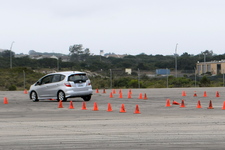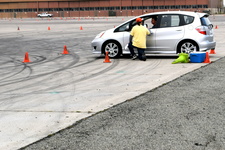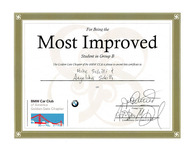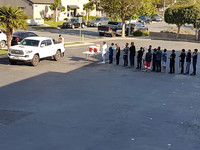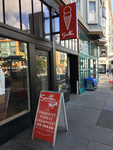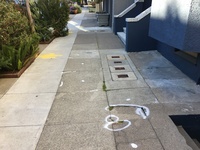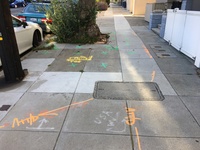 |
| Angelika/Mike Schilli |
Michael One of my colleagues is a passionate hobby race car driver who lets loose on official race tracks on the weekends. One day, he suggested that I participate in a so-called safety training, where you learn to skid your car without losing control. The training was conducted by the "Golden Gate Chapter" of the "BMW Club of America" on an old airfield just outside the town of Marina near Monterey. Now, I don't drive a BMW, but a 1998 Acura Integra, but you didn't need a BMW to participate. The fun cost about $200 per person, and I thought Angelika would surely enjoy it too, so I signed us both up. However, Angelika preferred to participate with her car, a 2011 Honda Fit, and I had concerns whether my Integra would pass the inspection since the conditions stated "must not leak oil," so I reluctantly agreed.
The training took place on a Sunday, so we drove the 100 miles down to Marina on Saturday, stayed overnight in a motel, and drove to the test site early in the morning. We felt quite underpowered because, during the vehicle inspection, a Lotus Elise was parked next to us, and many participants were driving BMW models M3 and M5. But at least no one laughed at us!
During a brief introduction, we learned that it was extremely important to overcome any fears and step on the gas so that the car would enter the extreme situations that mastering was the goal of the course. Nothing was worse than driving safely and learning nothing! Well, of course, they didn't have to tell me that twice.
Approximately two dozen instructors took care of the participants by jumping into the cars to ride along in the passenger seat while the drivers raced through a course of plastic cones. If the tires only squealed moderately and the driver didn't knock over any cones, they would shout, "Faster, you're too slow!" And if one of the drivers completely lost control and rammed sideways into a row of cones, there would be a standing ovation.
The first exercise was a braking maneuver, and I was amazed at how quickly a car with ABS can come to a stop from 30 mph when you slam on the brakes. In regular traffic, you can never try something like that because it's far too dangerous, but on an empty airfield with plenty of space, where at worst you might knock over a rubber cone, you can skid around with ease. Next, there were evasive maneuvers at around 30 mph with slight skidding and squealing tires, a circular drive where you adjust the radius only by accelerating and without steering, and finally a slalom course where we learned to bring the car to the traction limit of the tires at each cone until it almost went out of control.
That was such a huge amount of fun, you can't even imagine it. Angelika was a bit reserved at first, but by the end of the all-day course, she was also driving through the course with squealing tires, and the instructors were so pleased that they awarded us the special prize "Most Improved" of all the drivers in our group (see Figure 3).
I can warmly recommend the course to every driver. The enthusiasm of the instructors (by the way, all volunteers) was absolutely contagious, and the adrenaline rush when the car loses control is an unforgettable experience. And once you have practiced such maneuvers, you'll recall them later to avoid dangerous situations in traffic. This could eventually prove to be extremely useful.
Angelika Since our car rally started at 8 a.m. and took place 100 miles south of San Francisco, we stayed overnight in the Californian city of Salinas. If you're a fan of the American author John Steinbeck, you might have heard of Salinas. The author was born there in 1902, and many of his works, such as "The Grapes of Wrath," deal with Salinas and the migrant workers who still work in the fields in and around Salinas today. Salinas has only about 150,000 residents but is also called "the salad bowl of the world" because of its agriculture. There are also relatively many illegal immigrants living in Salinas, although there are no exact numbers because illegal immigrants are not exactly keen on making their immigration status public. However, everyone in California knows that people without papers work in the fields. The lettuce would probably be much more expensive if that weren't the case, or it would simply rot in the fields if the illegal labor were to disappear as Trump and his associates wish.
We stayed at a rural motel in Salinas, the kind you find all over America, because there were hardly any accommodations left. Apparently, everyone and their dog was traveling that weekend. We had already read on "Yelp" that workers who labor in the surrounding fields were also housed at the motel. This didn't bother us, of course. When the employee at the reception asked us if we wanted a room on the second floor and in the building that was further away from the street, we naturally said yes, because there's nothing worse in American motels than having a neighbor stomping around above you, as the buildings are almost always built with extremely thin walls. While unloading our luggage, we noticed that the doors to some rooms were open, and when we naturally peeked inside out of curiosity, we saw bunk beds, which are extremely unusual in motels. In front of the rooms, there was a neat row of work shoes lined up. Our room, of course, didn't have bunk beds, but we had our suspicions.
When we later returned from a short walk, we were somewhat startled because suddenly a bunch of young men stormed out of their rooms as if bitten by a tarantula. We suspected there was a fire alert. However, it turned out that the men were all lining up in a single file in the parking lot, patiently waiting in front of a white pick-up truck for the distribution of dinner. Some people maliciously claim that this is modern slavery.
Angelika After years of persuading Michael, I finally got a new bed a year and a half ago (Rundbrief 12/2016), and I thought to myself, that worked out well, now we also need a new sofa. After all, we've had our old one for almost 20 years, and it was getting a bit worn out, and I didn't like the shape as much anymore. So we tried out various sofas in furniture stores and eventually found the right model again at the Canadian furniture store EQ3. The waiting time for the good piece was a solid 6-8 weeks, as the sofa was built for us in Winnipeg, Canada, and upholstered with the fine leather we had chosen. When the delivery company informed us that our sofa was ready for its grand debut in our living room, we started to scramble a bit, wondering where to put the old one.
Anyone who has ever tried to give away an old sofa knows what I'm talking about. Our sofa was indeed older, but still in good condition. The fabric was a bit faded on one side and not as vibrant red as when it was new, but the sofa was neither sagging nor broken, so it was far too good for the junkyard. We thought, let's just donate the sofa to Goodwill (Rundbrief 03/2003) for a good cause, but it wasn't as easy as we thought. Goodwill is a large non-profit organization that accepts all kinds of donations, and they even want sofas. The company supposedly works with a third-party provider that picks up the sofas, but they never answered the phone or checked their voicemail when we called. By the time they finally called us back after weeks, we had already gotten rid of the old sofa. The organization "Salvation Army" also accepts sofas and even picks them up. However, the next available pickup date was four weeks later, and we didn't want to have two sofas sitting around in the apartment for four weeks.
Michael also made an effort on "Nextdoor" (Rundbrief 09/2014), the neighborhood portal, to get someone to take the sofa. An older couple was also interested and came by to try it out, but then realized that our sofa was too big for their apartment. We had, of course, provided the measurements, but they had apparently overlooked that. So Michael posted a classified ad on craigslist.org and lo and behold, a couple who had just moved to San Francisco from Singapore showed interest. But they lived on the other side of town, so how were they supposed to get the sofa from our apartment in Noe Valley to their place? Sure, you can rent a small truck from U-Haul, but the downside is that you have to carry the sofa to the truck yourself and drive the truck through the city on your own.
But in the age of the internet, someone has naturally already come up with the brilliant idea of offering the appropriate service for it. The company is called "lugg.com". "Lugg" apparently refers to lugging furniture, and it has been around since 2015, now in several cities in the US. The idea is that if someone wants to quickly transport a few pieces of furniture within city limits from point A to point B, but doesn't need a whole moving truck or doesn't want to become a mover themselves, they install the app on their phone and enter the details of the transport.
In the next step, the customer chooses whether they need a pickup truck with one "Lugger" (i.e., furniture mover) or two, or a slightly larger van. The cheapest option for just one piece of furniture with only one mover costs $33 base price plus $0.85 per working minute across the city. For two "Luggers," the price increases to $45 plus $1.45 per working minute. Similar to the ride services "Uber" or "Lyft" (Rundbrief 03/2013), the "Luggers" use their own vehicle. The brilliant thing is that the whole process is quick. You can have the moving truck at your door within half an hour, but of course, you can also book further in advance. So, the next big Ikea purchase that doesn't fit in your car is saved, because Ikea's own transport service usually takes much longer.
The idea for "lugg.com" came from Jordan Brown, who worked for a small healthcare startup in Salt Lake City and often encountered the furniture transportation dilemma. Brown developed the app and then moved to San Francisco to launch "lugg.com." The service is now available in San Francisco, Sacramento, Seattle, San Diego, Los Angeles, Silicon Valley, and Orange County.
Everything went well for us. The "movers" did drag our sofa a bit across the floor, which made me quite anxious, and of course, they didn't have a dolly with them (this seems to be a common phenomenon even among professional movers), but Michael is well-equipped in this regard. The new owners were able to track the sofa on its way to their apartment via the app, and after half an hour, it arrived safely. Our red sofa now has a new home.
Angelika That we have been living in San Francisco for over 20 years is also evident in how the skyline of San Francisco has changed over the years. Our apartment offers a great view of the city, and the skyscrapers have steadily increased over the years, so much so that the popular Transamerica Pyramid is almost swallowed up by the new glass towers. The new so-called Salesforce Tower, which opened in May, dominates everything now. Ironically, the company Salesforce didn't even exist 20 years ago when we moved to San Francisco. And now the latest skyscraper is named after the company that has rented most of the offices in the building, and you guessed it, "Salesforce." The skyscraper, at 1070 feet, is not only the tallest building in San Francisco but also the second tallest west of the Mississippi. It now surpasses the Transamerica Pyramid by 216 feet, which had been the tallest building in San Francisco since 1972.
Salesforce Tower really follows us around at every turn in the city, and you almost get startled when its somewhat bulky-looking tip suddenly juts out as if from nowhere. In the evenings, the tip lights up in all sorts of colors thanks to the light show consisting of 11,000 LED lights created by video artist Jim Campbell. It looks almost eerie when the tip emerges from the fog and seems to float on it. The street address of the Salesforce Tower is 415 Mission St., right in the heart of Downtown San Francisco and directly next to the new Transbay Transit Center, our regional bus hub.
The situation is not entirely without danger, as the building sits on ground of soft soil and sand, and the skyscraper is just a stone's throw away from the shore of the San Francisco Bay. In the event of an earthquake, however, soft ground can become a problem. Soft soil can sink during an earthquake and easily cause buildings to collapse. For this reason, tall skyscrapers were not particularly popular among the population of San Francisco for a long time, but the shortage of housing and office buildings has triggered a real construction boom.
There are now 160 buildings in San Francisco that are higher than 210 feet meters, and more are already in planning. All of them are located in downtown, in close proximity to each other, which is also risky in the event of an earthquake. Of course, everything is supposedly built to be earthquake-proof with the latest technology, but ultimately, the whole thing has not been tested in real life, only on paper or in computer simulations. Earthquakes are always unpredictable. And the fact that the Millennium skyscraper, another building which is not far from the Salesforce Tower, has been sinking for years and already has a measurable imbalance, doesn't exactly calm our nerves either.
Michael When a new store opens in San Francisco, for example, one that sells ice cream, you usually can't enter it during the first year of operation due to overcrowding. What I call "Internet lemmings" swarm around such stores like moths, and even if the line goes around the block, the millennial fool will still join the end of it. What's an hour wasted in such a meaningless existence as that of a hipster in San Francisco!
The store "Smitten Ice Cream" on Valencia Street around the corner from us had a similar experience. Initially, the ice cream shop was part of a mobile food truck caravan, then it moved into a store on the hipster strip, where it became so popular that you couldn't get in. But now, in about its second year of operation, the hipster crowd has moved on to newer ice cream shops, and you can simply walk into Smitten, order ice cream, pay right away, and start enjoying it within 5 minutes. The ice cream vendors there make the ice cream fresh when you order it, using dangerously hissing machines that, I believe, use liquid nitrogen or some other devilish substance to produce a few scoops of ice cream. The waffles also taste very good, which is why we treat ourselves to a portion every now and then.
The only bitter aftertaste, however, is the price, as a portion (waffle and a decent scoop) costs $7. Maybe I'm really getting old, but in my youth, a portion of waffle ice cream cost first 10 pfennigs, then 20, and today maybe one or two euros. In San Francisco, however, all popular shops now charge fantasy prices. Officially, the inflation rate is only a few percent per year, but anyone living here can tell you that the prices for everyday goods have certainly doubled, if not tripled, in the last 10 years. The salaries of high earners have also risen accordingly, so no one complains.
I only feel sorry for the tourists who come from Germany with their saved-up Euros, rubbing their eyes in amazement when they realize what crazy prices we pay for things that one could get in Europe at a fraction of the cost in similar quality. Well, the market will, as always, sort it out; eventually, every excess normalizes, and maybe then the hipster caravan will simply move elsewhere, and San Francisco will return to the sleepy hippie nest it once was. However, it is historically documented that such transformations can take decades, so I wouldn't speculate on it happening in the short term.
Michael Vacationing on Hawaii every year, doesn't that get boring at some point? For us, not really, because even after about 15 trips, we still haven't explored every corner. Although we have now been to each of the seven publicly accessible islands of the archipelago at least once, and in recent years we've only been hanging out on the main island of Oahu, we still haven't explored everything there.
One of these white spots on our map was previously the northwestern tip of the island. You first drive through the slightly rustic town of Waianae, then continue north, past some settlements of local beach bums, to the somewhat secluded, mainly frequented by locals, but breathtaking Keawaula Beach, until the coastal road abruptly ends and only a rocky, winding path leads into a nature reserve.
Travel guides can't stop going on about how cars are being broken into left and right there, but that's totally laughable, especially if you're from San Francisco, the world capital of petty criminals. You just don't leave anything in the car, and then no one will break into it —- problem solved.
In the first few hundred yards on the winding coastal path, we also saw a few parked off-road pickup trucks, whose owners had descended the narrow trails down the cliffs to go fishing. There was also a car that appeared to have veered off the path and crashed onto the rocks by the water.
After about half a mile, due to a broken off section, the path can only be continued on foot, and after another mile, the astonished hiker encounters a gigantic fence, which apparently has been erected by nature enthusiasts for the purpose of protecting albatrosses, an endangered bird species, from their natural enemies, some type of weasel.
In the breeding grounds of the albatrosses, we actually saw a surprisingly large juvenile albatros sitting in a nest on the grass, similar to the young adults nowadays called "Millennials," who, due to laziness and lack of income, still live with their mothers at the age of 25.
All the way up there on the northwestern part of the island, the waves break so powerfully that you think you are at the North Cape. Theoretically, you could continue on the trail walking east until you reach the eastern section of the coastal road, which runs along the north side of the island along the so-called "North Shore." However, we had, of course, parked our car at Keawaula Beach and therefore hiked back south. Overall, it was an extremely rewarding hike, only missing a proper inn to stop at the end of the trail, but that's something Americans somehow don't really go for.
Michael Normal Americans generally lack any interest in soccer. There's too little action on the field, endless back-and-forth in the midfield, and maybe a measly goal in 90 minutes -— it's just not that exciting. During the World Cup in Russia, we, as Germans living abroad, of course watched a whole series of games, but I have to say that I now find the ball kicking and the fuss surrounding the soccer players somewhat ridiculous.
Well, our German goon squad deservedly got knocked out in the preliminary round, and with that, the excitement for us was somehow already gone. When you no longer have a team to cheer for, the enjoyment of watching soccer on TV is reduced to the actual game itself, and that has somehow become stagnant over the years. Interestingly, no one questions how silly it actually is to watch 22 conceited peacocks, who place immense value on their hairstyles and tattoos, kicking a ball around. And what, as an adult interested in world affairs, do I care about a dim little light like Özil, whose footballing failure seriously occupied the evening news?
And then this constant cheating throughout the entire game! The constant falling down for no reason, the injury faking, the whining to the referee, the theatrical gestures at every whistle. What's happening on the field is simply pathetic and dishonorable. During free kicks, the players in the wall are now packed as tightly as in a slow fox dance and cling to their opponents like koala bears. Isn't that rather strange for heterosexual men?
Every time the ball goes out of bounds, the arms of two players go up, even though it's clear who knocked the ball out. How morally degenerate is someone who finds this normal, and what kind of person lets themselves fall in the penalty area to get a penalty kick to win the game, and then rolls around in joy? Probably a similar type of person who cheats on diesel emissions and then rejoices over the profits of the struggling German auto industry. That's just not my thing.
Michael A single-family home in our neighborhood now easily costs around 2 million dollars. However, what many newly wealthy people don't consider when buying a house is that paying off a loan of this amount over 30 years not only requires about $7,000 net per month, but also incurs a lot of additional costs.
Since the property tax in San Francisco is about 1.2% of the purchase price, for a two-million-dollar house, around $22,000 per year, or almost $2,000 per month, must be paid to the tax man. Fortunate is the one who has calculated this beforehand, before making an insane bid on a house; many techies with temporarily high salaries and zero knowledge realize this too late.
And in addition to garbage collection ($200 per month), electricity (up to $400 with the new eco-friendly provider), water, sewage, and all sorts of miscellaneous stuff, another $1000 per month quickly adds up. Repainting the house? $20,000. New roof? $20,000.
Many people also do not know that homeowners must repair the sidewalk in front of their house at their own expense if the typical approximately 3ft by 3ft stone slabs in San Francisco are starting to crack. This mainly happens because of trees, planted by the city at the roadside, which develop wild roots and destroy the stone slabs from below with intense pressure. If the unionized city inspection team then comes by and sees damage. The inspector marks the damage with a spray can, and shortly thereafter, a letter arrives in the mailbox, requesting the homeowner to repair the damage within 30 days.
And of course, not just any independent craftsman can take on the repair, but only those authorized by the city's union officials, who work at exorbitant prices. They start at $2,000, just to turn on the cement mixer.
Homeowners are, of course, resisting arbitrary actions by the authorities, and in the meantime, court rulings have been issued stating that damages caused by city tree roots after 2017 must very well be repaired by the city at their expense. Or take the 30-day ultimatum, issued for such tasks: The homeowner is only required to begin the repair within 30 days, but who knows how long it will drag on with unreliable craftsmen!
Recently, one hears from Germany that homeowners are getting upset about having to co-finance road construction in their communities, and they surely think: "Typical German bureaucracy! It would surely be different in America!" But they are mistaken, at least when it comes to liberal strongholds like San Francisco or California in general: There, the bureaucratic red tape is even more pronounced, and the financial burden on homeowners takes equally bizarre forms.
Greetings from the city:
Angelika and Michael


